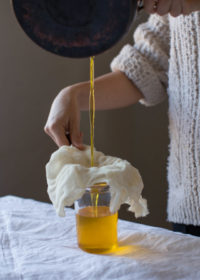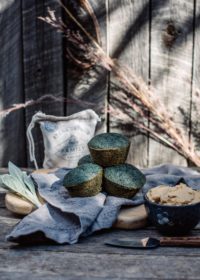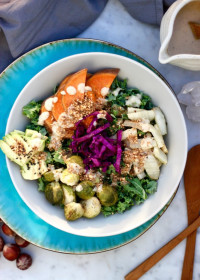Recipes: Morel Mushroom & Butternut Squash Pasta
![]()
![]()


Before I left Oklahoma, I got a chance to dig into some new cold weather recipe testing for Edible Magazine (my photo even made this month’s magazine cover feature, check it out below!). With this issue’s focus on foraging, I decided to experiment with some local edibles and ways to use these foraged gifts in wintertime when very little seems to come from the local land. Morel mushrooms are one of those local gifts that come in spring and many dry and store for the sparse months to spruce up their dishes.







1 small butternut squash, peeled & deseeded
3 tbsp ghee or olive oil
2 large shallots, sliced
4 cloves garlic, minced
1 cup morel mushrooms, rehydrated & sliced thinly
1 tsp coconut sugar
¼ tsp sea salt
4 tbsp sage, minced
1 tbsp lemon zest
1 cup kale, chiffonade cut
cracked black pepper
Preheat the oven to 375F.
If using dried morel mushrooms, place them in a bowl and cover with warm water to rehydrate. Once soft, drain and rinse well. Slice into thin 1/4-inch slices and set aside until ready to use.
Next, heat the ghee or oil in a large skillet on medium heat. Add the shallots and cooked until lightly translucent, about 1-2 minutes. Then, add the garlic and reduce heat to low. Allow these to slowly cook until a light golden color before adding the mushrooms. Stir in the sliced mushrooms and coconut sugar. Continue to stir and cook until lightly caramelized. Add in the sage and salt, and continue to cook for 1-2 minutes. Last, stir in the lemon zest and add the thinly sliced kale, stir until greens lightly wilt. Remove from heat, cover with lid and set aside while cooking the pasta.
Using a vegetable spiralizer, process the prepared squash through the machine to create long noodles. Place in a bowl and toss with olive oil, salt and pepper. Spread evenly across a baking sheet, and place in oven to cook for 15 minutes, or until lightly tender but not too soft. Remove from oven and plate the pasta while hot, adding the sautéed mushrooms and kale mixture on top and a dallop of pesto to each prepared plate or bowl. Season with a salt and pepper to taste.
Makes 4 servings
Dandelion Pesto
1 cup dandelion leaves
1 cup spinach leaves
½ cup parsley
½ cup basil
2 small cloves garlic
½ tsp salt
1 tsp lemon juice
¼ cup olive oil
Combine all ingredients, except the oil, in a food processor or blender. Pulse until well combined. Add the oil and pulse again. Transfer to an airtight glass container and store in your fridge until ready to use.
Makes roughly 1 cup
 [wpmenucart]
[wpmenucart]


